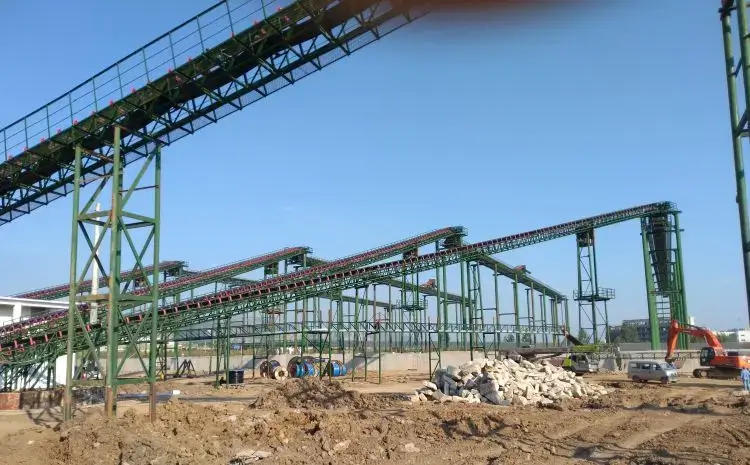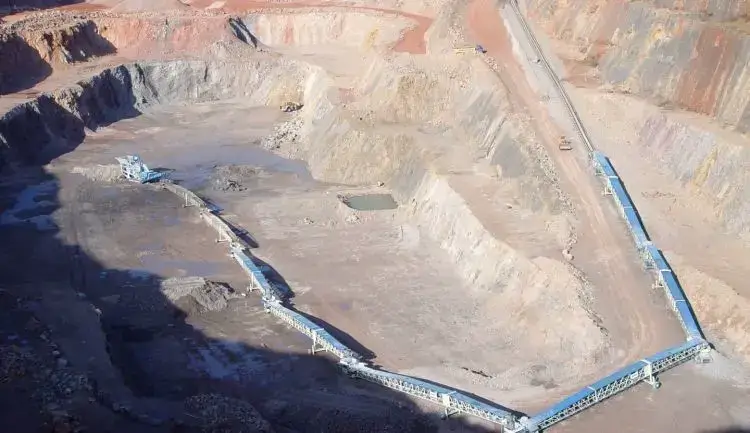Time:2025-08-07 11:19:57 Number of Clicks:
As the core scene of resource extraction, mines, ranging from narrow tunnels hundreds of meters underground to open-pit mines with rolling terrain spanning several kilometers, from iron ores with a Mohs hardness of 7 to clayey slag with a water content exceeding 30%, and from daily continuous mining volumes of ten thousand tons to sporadic transportation needs scattered across dozens of working faces, mine material conveying has always faced the triple challenges of "complex terrain, diverse materials, and equal emphasis on efficiency and safety".
Different types of materials such as coal, metal ores, aggregates, and chemical raw materials, due to differences in their physical properties, impose distinct requirements on conveying equipment. For example, coal conveying requires anti-spontaneous combustion, metal ores require wear resistance, and collapsible loess slag requires anti-clogging. How to achieve efficient, safe, and low-cost material transfer in such environments has become a core demand of mine operators.

For a long time, the mine conveying field has formed a traditional model dominated by "fixed routes + heavy transportation", but its shortcomings in complex scenarios have become increasingly prominent. Fixed belt conveyors, as the mainstream equipment, can realize continuous conveying with large inclination angles and curves, but their infrastructure costs are high, and once the route is formed, it cannot be adjusted. Facing the dynamic migration of mine working faces (advancing hundreds of meters annually), they often face the embarrassment of "disconnection between the conveying terminal and the working face" after 3-5 years of operation. Dump trucks, as a flexible supplement, are limited by fuel consumption (over 50 liters per 100 kilometers), maintenance costs (over 100,000 yuan per vehicle per year), and terrain adaptability (unable to pass when the slope exceeds 15 degrees). Even in rainy and muddy sections, there is an inefficient situation where "transporting 1 ton of material requires 2 liters of fuel".
More critically, traditional equipment is difficult to meet the special needs of mines: when belt conveyors handle sticky and wet materials, the belt adhesion rate can reach more than 15%, resulting in a 30% reduction in conveying efficiency; during truck transportation, the material spillage rate exceeds 5%, which not only causes resource waste but also leads to road dust (PM2.5 concentration can reach 8 times the national standard). In underground scenarios, the installation of fixed equipment needs to damage the original rock structure, increasing support costs; while small mobile equipment, due to insufficient power, is difficult to carry large-tonnage materials.
In response to the pain points of the traditional model, Zoomry Heavy Industry has developed mobile bulk material conveying equipment with "flexible adaptation, efficient collaboration, and environmental friendliness" as the core, which has gradually become an upgrading direction for mine conveying. Mobile bulk material conveying equipment gets rid of the constraints of fixed routes, can dynamically adjust the working position according to the mining progress, and realizes multi-scenario compatibility through modular design, fundamentally solving the three major problems of "terrain restrictions, efficiency bottlenecks, and high costs".
In the first key node of mine material transfer — the truck unloading link, the traditional manual unloading mode has problems of low efficiency and high safety risks. The use of truck unloaders can increase the efficiency of this link by more than 3 times, becoming the core hub connecting the working face and the conveying system.
Taking Zoomry Heavy Industry's truck unloader as an example, the equipment is divided into two basic configurations: wheeled and tracked, adapting to a processing capacity of 200-1800 tons per hour, with belt widths ranging from 1400mm to 1800mm, which can match various mine dump trucks of 15-100 tons. The core design is a "low-threshold, high-compatibility" unloading channel: the 3.5-5.7-meter-wide receiving hopper adopts a streamlined curved surface design, combined with adjustable deflectors, which can adapt to the unloading angles of different brand trucks to avoid material leakage; the 6.7-degree gentle slope design (12.1% slope) allows heavy-duty trucks to load smoothly without sudden braking, reducing tire wear and brake system loss.
In terms of intelligent configuration, the equipment is equipped with a radio remote control system, allowing operators to monitor the entire unloading process from 50 meters away, and cooperate with level sensors to realize automatic start and stop — when the material in the hopper reaches the preset height, the system automatically decelerates to receive, avoiding overflow; when the material is below the lower limit, it automatically sends a replenishment signal. For scenarios where multiple vehicles operate simultaneously, the 4-channel unloader can realize "parallel unloading", handling up to 30 truck trips per hour, which is 200% more efficient than the traditional single-channel mode.
In terms of special environment adaptability, the tracked unloader adopts widened tracks (ground contact area up to 2.8㎡), with a ground pressure as low as 60kPa, which can work stably in muddy mine roads or soft topsoil areas; the wheeled model is equipped with explosion-proof tires and anti-skid chains, suitable for rapid transfer on hardened roads (speed up to 15km/h). It reduces labor costs, improves truck turnover efficiency, and thus saves operating costs.
The storage link of mine materials is not only related to storage capacity but also directly affects the efficiency of subsequent processing — traditional fixed stacking methods easily lead to material segregation (large particles sink, small particles float), requiring an additional 20% processing time for subsequent crushing and screening. The use of mobile stackers can solve this problem from the source through "dynamic storage control" technology.
The core advantage of Zoomry Heavy Industry's mobile stacker lies in "precise control in three-dimensional space": the radial rotation angle can reach 360 degrees, the telescopic boom length is adjustable from 15 meters to 30 meters, and combined with the luffing mechanism (up and down swing angle ±15 degrees), it can build a conical stockpile with a height of 20 meters. The "layered stacking" mode can increase the storage density by 15%, and the storage capacity of the same site is increased by 28% compared with the traditional method, greatly reducing the area of the stockyard.
The key components of the equipment adopt industrial-grade standards: the surface of the idlers and rollers of Zoomry Heavy Industry has undergone carbonization treatment, with wear resistance increased by 3 times; the drive system can be optionally equipped with top-brand gear motors, combined with frequency conversion speed regulation technology, which can adjust the conveying speed (0-2.5m/s adjustable) according to material properties (such as viscosity and hardness). For high-altitude mines (altitude over 3000 meters), the equipment can be customized with low-temperature start-up kits (normal operation at -30℃) and anti-ultraviolet coating; in rainy areas, the closed belt cover and rain shelter can effectively prevent materials from getting damp and caking.
In terms of environmental performance, the stacker is equipped with a negative pressure dust removal device (air volume 2000m³/h), which can control the dust concentration below 10mg/m³, and combined with the spray system (coverage radius 8 meters), it can meet the EU mine environmental protection standards.
When there are complex terrains such as deep trenches, steep slopes, and tunnels between the mine working face and the stockyard, the use of traditional conveying equipment not only faces problems such as site construction and equipment maintenance but also needs to solve the time cost caused by conveying efficiency. The use of grasshopper conveyors can flexibly cross obstacles through "cascading connection" technology, building a highly adaptable temporary conveying route.
Grasshopper conveyors are divided into wheeled and tracked types. A single piece of equipment has a length of 15-40 meters, and the conveying capacity covers 200-800 tons per hour (for example, the ZR65D model is 200TPH, and the ZR120D model reaches 800TPH). Its core design lies in "modular splicing": each equipment is equipped with quick docking devices at the head and tail, and through a laser positioning system (accuracy ±3mm), the mechanical and electrical connection of two devices can be completed within 30 minutes. When 15 units are cascaded, the total conveying distance can reach 600 meters, and it can adapt to a slope change of ±15 degrees, and can also operate stably in mountainous mines with an altitude drop of 200 meters.
The tracked grasshopper machine adopts a hydraulically driven track, with a minimum turning radius of only 5 meters, which can complete steering in a 3-meter-wide tunnel; the wheeled model is equipped with pneumatic tires, with a transfer speed of 20km/h, suitable for long-distance movement. The equipment's folding arm design (length shortened by 50% after folding) enables it to enter underground through mine elevators or narrow-gauge trains, solving the problem of conveying connection between underground and ground.
In terms of collaborative control, multiple grasshopper conveyors can be linked through an industrial bus. The central control system monitors the conveying volume of each section in real-time and automatically adjusts the speed difference between adjacent equipment (controlled within 5%) to avoid material accumulation or breakage.

The efficiency of a single device can only be maximized through system collaboration. Scientifically combining equipment such as truck unloaders, grasshopper conveyors, and mobile stackers can form a closed-loop conveying system covering the entire process of "mining - transfer - storage", with an efficiency increased by more than 50% compared to the traditional model.
A typical collaborative process design is as follows: materials mined underground are transferred to the underground temporary warehouse by small scrapers, transported to the ground by elevators, and then transferred to the truck unloader by 25-ton dump trucks (unloading time per truck is controlled within 3 minutes); the unloader conveys the materials to 3 cascaded grasshopper conveyors (total length 90 meters) to cross the gully between the mining area and the stockyard; the end of the grasshopper conveyor is connected to the mobile stacker, forming a 15-meter-high stockpile through radial stacking; the stored materials are transported to the crushing workshop by another group of grasshopper conveyors as needed to complete subsequent processing.
The core of multi-equipment collaboration is "dynamic adaptation": when the working face advances 50 meters, the conveying line can be extended only by adjusting the positions of 2 intermediate grasshopper conveyors without overall reconstruction; in case of heavy rain, the unloaders and stackers working in the open air can be transferred to the shed, and indoor closed-loop conveying can be realized through grasshopper conveyors to avoid materials getting damp.
Different mine types need to match differentiated solutions: open-pit coal mines prefer the combination of "wheeled unloader + tracked grasshopper conveyor + mobile stacker", focusing on efficient transfer and anti-spontaneous combustion design; metal mines recommend "tracked unloader + multi-stage grasshopper conveyor" to enhance equipment wear resistance; underground mines need to use miniaturized grasshopper conveyors (width ≤ 2.5 meters) combined with folding stackers to adapt to tunnel space constraints.
Equipment selection needs to comprehensively consider purchase costs and operating costs: for example, tracked equipment is more expensive than wheeled ones, but maintenance costs on soft ground are reduced; equipment equipped with intelligent control systems has increased initial investment but can reduce labor costs with a short investment recovery period.
All equipment of Zoomry Heavy Industry must pass mine safety certifications (such as China's MA certification, EU's ATEX certification), with emergency stop buttons, anti-deviation devices, and overload protection set at key parts; dust emissions must comply with "Limits of Dust Concentration in Mines" (GBZ 2.1), and high-efficiency filters (filtration efficiency ≥ 99.9%) must be installed in sensitive areas.
The upgrading of mine conveying is not only the update of equipment but also the implementation of the "dynamic adaptation" concept. Through the efficient unloading of truck unloaders, precise storage of mobile stackers, flexible crossing of grasshopper conveyors, and collaborative linkage of multiple equipment, a "flowing conveying network" adapted to the complex mine environment can be built, improving efficiency while reducing costs and environmental impact, and providing a solid guarantee for the sustainable development of mine resources.
Copyright © 2002-2024 Zoomry Group Company Limited